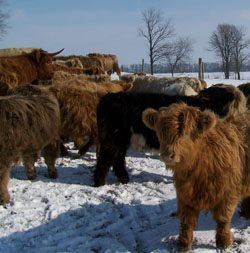Stock for Sale

Our Goal
Cairdeas Druim Farm works to maintain the Scottish ideal in order to preserve this beautiful and noble breed. We have several show quality animals available for purchase.
So what is the perfect Highland animal?
“It is generally agreed that the well bred Highland is the most picturesque animal in the cattle world. Straight above and below, short in the legs, deep in frame, rich and flowing in hair at the proper time of year, varied in colors and singularly dignified in movement...
There are two styles of horn in females - the out, slightly forward and upward; and the out, less forward and backwards swirling. In a bull a wide level sweep is best. As the animal approaches maturity, the horns take a moderately forward set and tend to rise, if anything at the tips.
At the fall of the year and in the winter the brow of the well-bred bull or heifer should be like a sporran, with straight flowing hair down to the edge of the nose, and leaving not more than a mere peering opportunity for the eye. Long hair should also fall from the ridge of the neck, the spinal column, and should be abundant down the thighs. A long fringe should also hang from the lower edge of the ears. I always think this is a sign of good breeding. It is a consequence to have a very thick, soft undercoat, or ‘vest’. The fact is that I would not have great confidence in a feeding animal that showed deficiency in vest. Towards the end of the summer when calves have cast a good deal of their first coat, they should still show plenty of ‘apron’ along the low line.....”
James Cameron in "Preserving a Noble Old Breed and quoted by A McKenzie in Highland Cattle Today and Yesterday"
While this describes the Scottish, ideal Highland animal, it does not describe the current American ‘ideal’ Highland animal. Unfortunately in America we are breeding our cattle to cater to the “judge’s” ideals and beliefs of quality. When we, as American breeders, take our animals to shows, we all want to win. Therefore we breed to accommodate the opinions of the people judging our animals. Most judges however, raise more traditional American breeds, rather large leggy animals with long bodies and necks and while they are good cattlemen, they generally do not know or understand the Highland breed. In our zeal to win points and become well known as having superior quality animals, we have been breeding animals to meet the ideals and standards of non-highland breeders. In my personal opinion we have imposed an incredible injustice to the breed.